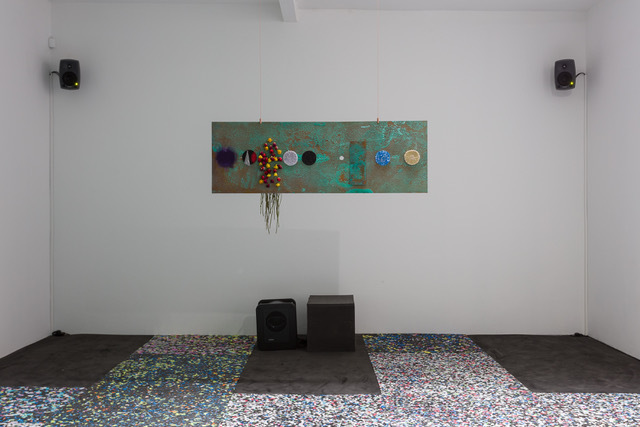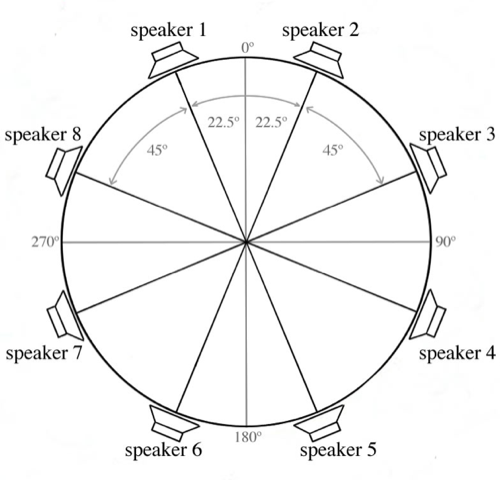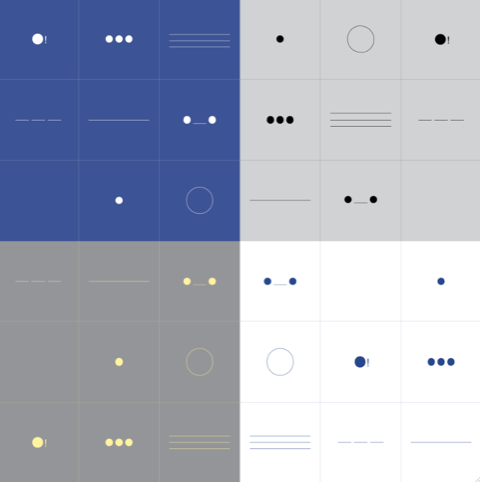This heteronormative dictum was the impetus for The Pitch Sisters (2012), an immersive multichannel electroacoustic composition by London-based artist Ain Bailey. Visitors enter a room in which they are surrounded by the sound of about fifty female vocalists all performing at the so-called preferred pitch, yet the multiplicity of timbres, as Bailey discusses in this interview, exposes “the ludicrous idea of the homogeneity of women’s voices.”
Bailey’s experiments with sound evolved from her passion for DJing. The DJ has been called “part shaman, part technician, part collector, part selector, and part musical evangelist.” Bailey’s zeal for igniting a roomful of people and taking them on a musical journey extends into her practice as a sound artist, with her interest in architecture and sound, performance and public space, as well as her collaborations with other artists, and her workshops exploring sonic autobiography.
What was the sonic environment of your childhood? How did you get interested in sound as an art form?
Oooh . . . great question! I’m going to make a list.
Brixton Market in the 1970s and 1980s.
Milk carts and then milk floats.
Rag-and-bone men—and they were usually men—and their horses
Ice cream vans playing their jingles—and the ensuing joyful sound of children on the street running to get their ice creams and lollies.
The ding-ding of the bell on a string on the old Routemaster buses.
The sound of the bus conductor’s ticket machine. We’ve come a long way from those!!!!
Johnny Nash; Desmond Dekker; Radio Luxembourg; Donna Summer; The Alessi Brothers; Evelyn “Champagne” King; Val Doonican; Jim Reeves.
The clunking of an old stereo. I remember we had a record player where you could stack seven-inch singles on the spindle and they would automatically drop and play once the previous one had ended, after the arm had returned to its holder.
Cricket matches.
Steel pans.
Old telephone boxes and the sound of coin after coin being deposited in the slots. This was before we had a landline at home.
You also work with others to explore their sonic autobiographies?
When writing workshop proposals or discussing what a sonic autobiography is, I always ask people to think about sounds—either songs/music or sounds from their lives/environments that hold special memories of a time, place, person, event. It is completely up to them to decide what sounds they deem important. I never suggest what they should share, but I will offer guidance if they struggle to think of a sonic memory.
You describe the work And We’ll Always Be a Disco in the Glow of Love as an attempt to “sonify grief.” Can you say more about this piece? I’m especially interested in the verb “to sonify.”
And We’ll Always Be a Disco in the Glow of Love is a conversational starting point for myself, my community, and beyond to start articulating how we experience grief and how we are deeply traumatised by it. When I had grief counselling after my mother passed away, one of the first things the counsellor told me was that grief never goes away; we just learn to build our lives around it. I find myself feeling pangs of grief when I see Caribbean women wearing the same style that my mum used to wear. Or, as featured in this work, hearing the hymn “Amazing Grace,” which for the longest time was incredibly difficult. Therefore, the composition sought to discover through this medium how sound and grief were linked for family and friends. It’s incredibly interesting that in the sonic autobiography workshops that I facilitate, death regularly features. Also, I should mention, I consider myself an electroacoustic composer. That is, I use sounds taken from the environment and do my compositional thing with them to create work. For And We’ll Always Be a Disco in the Glow of Love, the starting point was the sonic material of the invited participants.
In the workshops that I facilitate, I normally ask participants to bring along three or so sounds to share. One by one, we take turns listening to the sound, and the person can share, or decline to share, the reasons why the song is important. We complete a full circle and go again. Normally we run out of time. These sessions are rarely recorded. The only times they have been were when it was part of my “Congregation” residency at London’s Institute of Contemporary Art. Even then, one participant chose to withdraw consent for participation in the recording. It was an extraordinarily emotional event, and I completely understand why someone might not want that then laid out for public consumption.
In terms of an experience being sonified, I always think this is what songwriting aims to achieve. The composer takes a moment, an event, a happening, and tries to convey that through the medium of music or verse. I try to do the same with my compositions. Of course, those listening to my work bring their own life experiences to that, so the meaning can end up becoming something totally different to the intended meaning.

Ain Bailey. And We’ll Always Be A Disco in the Glow of Love (2019). Cubitt Gallery, London. Installation shot. Photo credit: Mark Blower.
You identify as both a sound artist and a DJ. What is your DJing style?
I’d call myself a selector, as the focus isn’t on a complete mastery of the ones and twos on either vinyl or CD. Depending on the context, but especially in a club environment, I want people to dance. End of! I’m always trying to enjoy myself when spinning. Folk might say I fully inhabit the DJ booth. I’m pretty animated if I’m having a good time. But if I’m not moving, it doesn’t mean anything is wrong. It’s probably just a different kind of vibe in the space; for instance when DJing in a hotel bar.
In terms of what I actually play, it’s incredibly eclectic. When at a dance party, I like to mix house, in all its various forms—such as minimal, soulful, and tech—through to disco, jazz, and other bits and pieces in between. DJs often talk about taking dancers on a real journey, and while it might sound like a cliché, this is absolutely one of the joys of playing to a crowd who are completely up for it.
How has DJing informed your practice as a sound artist?
Hmmm . . . there are techniques that I use in DJing, such as playing with the faders, that I sometimes use in my sound art work but, for the most part, I would say it’s another star in my sonic constellation, which also includes installations, facilitating workshops, composition, performance, and collaborations.
Having said that, the way in which I began to compose did come directly from DJing. A friend suggested that, if I wanted to get more gigs as a DJ, I should make my own music. Taking this to heart, I enrolled in a music production course to learn Logic digital audio workstation, and to begin to make sounds. Most other folk there—who, I think, were all men—had musical experience. I had none as such—I’d played the saxophone in the 1980s for a bit. As part of the course, we recorded “Proud Mary” by Ike and Tina Turner. I cringe at the memory of laying down some vocals. I don’t think it was pretty! From then on, I tried to make house music in various other courses.
The pivotal moment was, perhaps, when I was invited by Stephanie Thiersch, of the dance company MOUVOIR, to collaborate on a dance performance entitled “Beautiful Me.” This collaboration included Maria Stamenkovic Herranz, Stephanie, and the late Bettina Buck. For the show, I provided music by DJing tracks that I had selected to accompany Maria. At the same time, I thought this was a great opportunity to try my hand at composing in a different way. I’d been gifted a sample library prior to working with MOUVOIR, and I used samples from this to create the composition “Audition,” which can be listened to on my SoundCloud.
In a bid to learn more about electronic music, I enrolled in a year-long sonic arts course at London College of Communication, where I discovered the works of Janet Cardiff and R. Murray Schaefer, and developed a greater understanding of the work of Pauline Oliveros, Christine Kubisch, and many, many, many others, and began to develop my compositional style. So, yeah, long story short, DJing did influence my move into the sonic arts.
Tell us a little about the evolution of The Pitch Sisters.
The original composition was composed for a configuration of 8.1 audio monitors and subwoofer. It is twenty-three minutes and forty seconds in length. What you are listening to in the excerpt on SoundCloud is a fragment of the composition. The initial concept was inspired by Leslie Thornton’s film Peggy and Fred in Hell: The Prologue. A spoken line within the film, taken from archival footage, states that the preferred pitch of a woman’s voice is A flat below middle C. I took this line as a starting point for the composition.
I recorded over fifty women uttering an A-flat below middle C. To guide them, I had a tone generator on a mobile phone, as most of them did not have perfect pitch. Once the material had been gathered, I imported them in Pro Tools and then sampled, edited, and created the composition. The aim of the composition was essentially to demonstrate the ludicrous idea of the homogeneity of women’s voices, and to revel in the multiplicities of voices.

Eight-channel speaker diagram. Courtesy of the Electronic Music Studios, Goldsmiths, University of London.
I’m really interested in the score graphics below. Can you tell me about what I’m seeing?
I created the graphic scores for the live performance of The Pitch Sisters. Firstly, the images depict some of the different colour schemes that Laura Varzgalyte, the graphic designer, made beautiful for me. Each symbol, within each of the nine boxes, denotes a different vocal action to be taken by a performer. So, taking the first box with the top left-hand score with the black background, the first symbol of a large dot with exclamation mark instructs the performer to do a loud, but short “Ha!” Moving across to the three smaller dots, this is an instruction to utter three shorter ha’s one after the other. Then the three long lines ask the performer to take a breath and sound a note for as long as the breath lasts. Three times. And so on.
The performers, Hamida Yusfuzai, Stefanie Ritch, Flora Pitrolo, and Sojourner Jones, each started in a different-coloured part of the score. Once they completed their section, they moved on to the next colour, and this repeated until the end of the composition. It should also be noted that, as well as the four vocalists for the performance, I asked a dear friend, Ego Ahaiwe Sowinski, to conduct, thereby lending another dynamic to the performance. Ego would ask the performers to stop. To be quiet or to be louder. Or solo. And so on.

Ain Bailey. The Pitch Sisters graphic score (2013). Graphic design by Laura Varzgalyte.
I absolutely love Five Car Train to Fremont (as excerpted on SoundCloud). Can you tell me how this was composed? How did the work of audiovisual artist and composer Jockel Liess inspire this piece?
Thank-you. Jockel was preparing to release his track “Irregular Atmospheric Motion” on Adam Matschulat’s Resterecords label. He’s always been a great supporter of my work, ever since our time together on the MMus Studio Composition degree at Goldsmiths, University of London. Having heard and experienced a lot of my work over the years, he was interested in how I might interpret one of his compositions.
I spent a very long time thinking about how I might work with the stems that he sent to me. My compositional process often requires a long gestation period. In late 2018, I undertook the “Congregation” residency at the Institute of Contemporary Arts in London. It was here that I was able to spend some focused time, away from a domestic setting, to concentrate on the work.
Again, as with most of my work, I use a variety of sampling methods to create the different sounds you might hear—generating a myriad of textures, rhythms, and loops. I also incorporated field recordings taken on a trip to San Francisco and Oakland, as a way to perhaps create a conversation between Jockel and myself. The way in which Jockel composes is fascinating, and to be honest, I don’t have any real idea about how he works with Max/MSP to create them [the compositions]. All I do know is that the audiovisual works are generative and normally created from a single sonic source. He once created a visual work using tapioca! No idea how. Part of his methodology is to simulate natural acoustic and visual environments/processes, sonifying them for compositions. Recently, Jockel finished a work where he collaborated with a virologist exploring viruses and their patterns. Fascinating and heady stuff.
